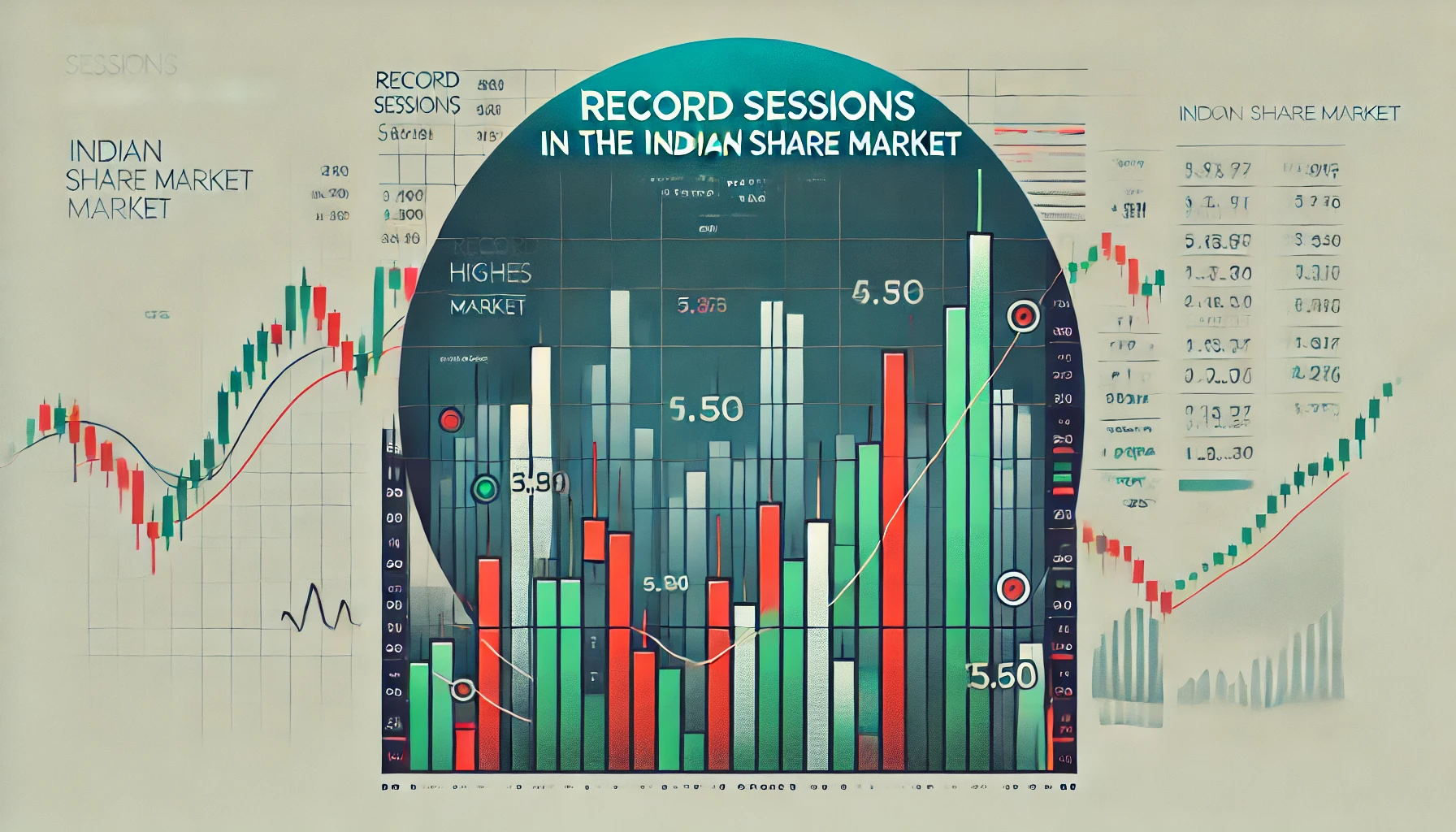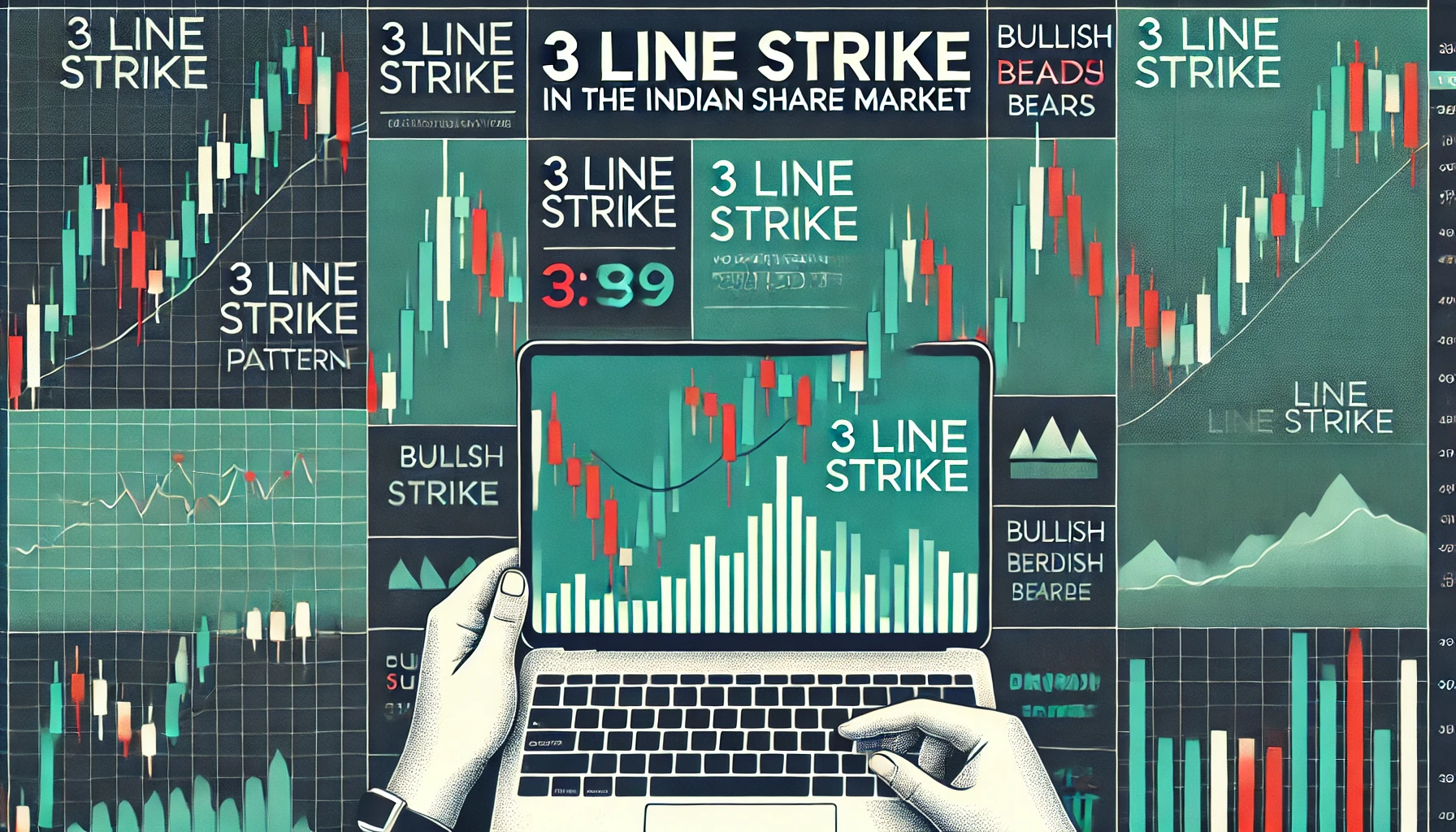In the world of technical analysis, candlestick patterns are powerful tools that help traders make informed decisions. One such pattern is the Harami pattern, which is highly effective in predicting potential market reversals. Originating from Japanese candlestick charting techniques, the Harami pattern has become a popular indicator in the Indian share market for spotting bullish and bearish reversals.
This blog will take a deep dive into the Harami pattern, its significance in the Indian stock market, and how traders can use it to improve their strategies. We’ll also look at historical data to assess its accuracy and impact on trading decisions.
What is the Harami Candlestick Pattern?
The Harami pattern is a two-candle formation that indicates a potential reversal in market trends. It consists of two candles: a large candle followed by a smaller candle that is fully contained within the body of the first. The name “Harami” means “pregnant” in Japanese, as the second, smaller candle appears “inside” the body of the first one.
There are two main types of Harami patterns:
- Bullish Harami: This occurs during a downtrend and signals a potential reversal to the upside. The first candle is large and bearish, while the second is smaller and bullish.
- Bearish Harami: This occurs during an uptrend and signals a potential reversal to the downside. The first candle is large and bullish, while the second is smaller and bearish.
Components of the Harami Pattern
To better understand the Harami pattern, let’s break down its key components:
- First Candle (Mother Candle): This is a large candle that indicates the current market trend. In a bullish Harami, the first candle is bearish, and in a bearish Harami, it is bullish.
- Second Candle (Baby Candle): This is a smaller candle that appears within the body of the first candle. It shows indecision in the market and hints at a potential trend reversal.
The Harami pattern is considered more reliable when it occurs at key support or resistance levels or when confirmed by other technical indicators like the Relative Strength Index (RSI) or Moving Averages (MA).
Historical Performance of the Harami Pattern in the Indian Share Market
The Harami pattern has been a valuable tool for traders in the Indian stock market. By spotting potential reversals early, traders can enter or exit trades at more opportune moments. Let’s examine the historical performance of the Harami pattern using the Nifty 50 index as an example.
Table 1: Historical Harami Pattern Signals for Nifty 50 (2016-2023)
| Year | Nifty 50 Close | Harami Pattern Type | Market Condition | Resulting Move (%) |
|---|---|---|---|---|
| 2016 | 8,200 | Bullish Harami | Downtrend | +4.5% |
| 2017 | 9,900 | Bearish Harami | Uptrend | -3.2% |
| 2019 | 11,500 | Bullish Harami | Downtrend | +6.0% |
| 2020 | 7,500 | Bullish Harami | Bearish Reversal | +12.5% |
| 2021 | 14,500 | Bearish Harami | Bullish Reversal | -5.0% |
| 2023 | 18,000 | Bullish Harami | Bearish Reversal | +3.5% |
The table demonstrates how the Harami pattern has consistently signaled reversals during key points in the market, providing traders with valuable insights into potential price movements.
How to Trade Using the Harami Pattern in the Indian Share Market
The Harami pattern can be used as part of a broader trading strategy to identify potential reversals. Here’s a step-by-step guide on how to trade using this pattern:
Step-by-Step Guide for Trading the Harami Pattern
- Identify the Trend: Before acting on a Harami pattern, determine whether the market is in an uptrend or downtrend. This will help you decide whether to trade a bullish or bearish Harami.
- Confirm the Pattern: Look for the two-candle formation where the second candle is smaller and fully contained within the body of the first. In a bullish Harami, the first candle is bearish, while the second is bullish. In a bearish Harami, the first candle is bullish, while the second is bearish.
- Wait for Confirmation: The Harami pattern is stronger when confirmed by other technical indicators, such as the Relative Strength Index (RSI) or the Moving Average Convergence Divergence (MACD). Look for signals that confirm the potential reversal.
- Set Entry and Exit Points: Once the Harami pattern is confirmed, set your entry point at the breakout of the second candle’s high or low. For bullish Harami, enter when the price moves above the second candle’s high. For bearish Harami, enter when the price moves below the second candle’s low.
- Place Stop Losses: To protect against false signals, place stop losses just below the first candle in a bullish Harami, or above the first candle in a bearish Harami.
Example: Trading the Harami Pattern on Nifty 50 During the 2020 Market Crash
During the COVID-19 market crash in 2020, a bullish Harami pattern appeared on the Nifty 50 as the market began to stabilize. Traders who spotted this pattern and entered long positions at the breakout of the second candle’s high could have captured significant gains as the market rebounded.
Table 2: Harami Pattern Signals During Nifty 50 Recovery (2020)
| Date | Nifty 50 Close | Harami Pattern Type | Signal Generated | Market Move (%) |
|---|---|---|---|---|
| March 2020 | 7,500 | Bullish Harami | Go Long | +15.5% |
| June 2020 | 10,000 | Bearish Harami | Stay Short | -4.0% |
| December 2020 | 14,000 | Bullish Harami | Hold | +12.0% |
This table illustrates how traders could have used the Harami pattern to navigate the market crash and subsequent recovery, avoiding significant losses and capturing gains.
Advantages of the Harami Pattern
- Early Reversal Signals: The Harami pattern is excellent at signaling potential reversals before they fully develop, allowing traders to act early and maximize their returns.
- Clear Entry and Exit Points: The Harami pattern provides straightforward entry and exit points, making it easy for traders to incorporate into their strategies.
- Works in Multiple Markets: The Harami pattern can be applied to various markets, including equities, indices, commodities, and forex, making it a versatile tool for traders.
- Combines Well with Other Indicators: While the Harami pattern is effective on its own, it works even better when used with other technical indicators like the RSI, MACD, or Bollinger Bands to confirm signals.
Limitations of the Harami Pattern
While the Harami pattern is a valuable tool, it does have some limitations:
- False Signals: The Harami pattern can produce false signals, especially in range-bound or volatile markets. Traders should use confirmation from other indicators to minimize the risk of acting on false signals.
- Requires Patience: The Harami pattern can take time to play out. Traders need to be patient and wait for confirmation before entering or exiting trades.
- Best for Swing or Medium-Term Trading: The Harami pattern works best for swing or medium-term trading. Short-term or day traders may find it less effective due to its slower development.
Comparison with Other Candlestick Patterns
To better understand the strengths and weaknesses of the Harami pattern, let’s compare it with other popular candlestick patterns like the engulfing pattern and the morning/evening star pattern.
Table 3: Comparison of Harami, Engulfing, and Morning/Evening Star Patterns
| Pattern | Best For | Strengths | Weaknesses |
|---|---|---|---|
| Harami | Spotting early reversals | Clear entry and exit points, works across markets | Can give false signals in volatile markets |
| Engulfing | Confirming reversals | Strong signals, easily recognizable | Requires confirmation, not as early as Harami |
| Morning/Evening Star | Trend reversals | Reliable, strong reversal signal | Requires three candles, slower signal |
The Harami pattern stands out for its ability to provide early reversal signals, making it a valuable tool for traders who want to act quickly in changing market conditions.
Real-World Application of the Harami Pattern in the Indian Market
The Harami pattern has been successfully used by traders in the Indian share market to capture market reversals and optimize their trading strategies. Whether during market crashes or rallies, the Harami pattern has consistently provided traders with reliable signals.
Table 4: Harami Pattern Performance in the Indian Market (2020-2021)
| Event | Nifty 50 Close | Harami Pattern Type | Signal Generated | Market Move (%) |
|---|---|---|---|---|
| COVID-19 Crash | 7,500 | Bullish Harami | Go Long | +15.0% |
| Post-COVID Recovery | 14,000 | Bearish Harami | Stay Short | -5.0% |
| 2021 Bull Market | 18,500 | Bullish Harami | Hold | +10.0% |
This table highlights how the Harami pattern has helped traders navigate key market events, providing valuable reversal signals.
Conclusion
The Harami candlestick pattern is a powerful tool for traders in the Indian share market, offering clear and early signals of potential reversals. By combining the Harami pattern with other technical indicators, traders can increase their chances of making informed decisions and capturing profitable opportunities.
Whether you’re a beginner or an experienced trader, mastering the use of the Harami pattern can significantly enhance your ability to spot market reversals and improve your trading strategy.

What is the TRIN stock market indicator?
The TRIN (Trading Index), also referred to as the Arms Index, is a technical analysis …

Record Sessions
The Indian share market is a dynamic and volatile space where major highs and lows …

3 Line Strike
Candlestick patterns are a vital tool for traders in the stock market, offering insights into …

3 White Soldiers and 3 Black Crows
Candlestick patterns are a key element of technical analysis in stock trading, offering clear signals …

Gapping Doji
Candlestick patterns are a critical part of technical analysis in the stock market, providing traders …

3 Windows
Candlestick patterns are a vital part of technical analysis, offering traders and investors insights into …

2 Gapping Candles
In the fast-paced world of the Indian stock market, technical analysis plays a crucial role …

3 Inside Down and Up
Candlestick patterns are powerful tools in the world of technical analysis, offering traders insight into …

Bullish and Bearish Belt Hold
Technical analysis is an essential part of trading in the Indian share market. Candlestick patterns, …

Piercing and Dark Cloud Cover
In the ever-evolving Indian stock market, candlestick patterns are crucial for traders aiming to predict …

Double Doji
Candlestick patterns have long been a favored tool for technical traders to forecast market movements. …

Rising and Falling Windows
In the world of technical analysis, candlestick patterns are vital tools for traders to anticipate …

Tweezer Top and Bottom
In the fast-paced world of the Indian share market, traders use technical analysis tools to …

Morning Star and Evening Star
In the Indian share market, technical analysis is a valuable tool for traders aiming to …

Hammer and Hanging Man
The Indian stock market offers a wealth of opportunities for traders who understand technical analysis. …

Shooting Star and Inverted Hammer
The Indian stock market, with its dynamic nature, presents various opportunities for traders and investors. …

Last Engulfing
The Indian share market is filled with patterns that can help traders make informed decisions. …

Harami
In the world of stock market analysis, candlestick patterns offer valuable insights into price movements. …

Engulfing
The Indian share market is known for its volatility, and traders often rely on technical …

Marubozu
Candlestick patterns are powerful tools used by traders in the Indian share market to analyze …

Spinning Top
The Indian share market, like any other, experiences constant fluctuations due to a multitude of …

Doji
The Indian share market is dynamic, with investors using various tools to gauge stock performance. …

Double Top
In the world of technical analysis, chart patterns are valuable tools that help traders spot …

Tweezer
In the Indian share market, where volatility and price fluctuations are part of daily trading, …

Harami
In the world of technical analysis, candlestick patterns are powerful tools that help traders make …

Heiken-Ashi
Navigating the Indian share market can be challenging due to the inherent volatility and market …

Ichimoku
In the world of technical analysis, few indicators offer the comprehensive insights that the Ichimoku …

Value Charts
In the ever-changing landscape of the Indian share market, traders and investors need tools that …

Money Flow Index
In the Indian share market, identifying trends, understanding momentum, and assessing volume are critical components …

Aroon
In the fast-paced world of the Indian share market, identifying market trends and spotting reversals …

Gator Indicator
In the Indian share market, success is largely dependent on identifying the right trends and …

Adaptive Moving Average
In the dynamic and often volatile Indian share market, traders and investors continuously seek tools …

Coppock Curve
In the ever-evolving landscape of the Indian share market, traders and investors rely on technical …

Premier Stochastic Oscillator
In the fast-paced world of the Indian share market, technical indicators are indispensable tools that …

Dynamic RSI
The Indian share market is known for its volatility, with frequent shifts in trends influenced …

Vortex
The Indian share market offers plenty of opportunities for traders and investors to capitalize on …

Glitch Index
The Indian share market, like all financial markets, is prone to moments of irregular behavior—unexpected …

Triple Exponential Average
Navigating the Indian share market requires traders to use effective tools that help them track …

Know Sure Thing
The Indian share market presents countless opportunities for traders and investors, but making accurate decisions …

Mass Index
The Indian share market is volatile, with price trends constantly shifting due to numerous factors. …


















